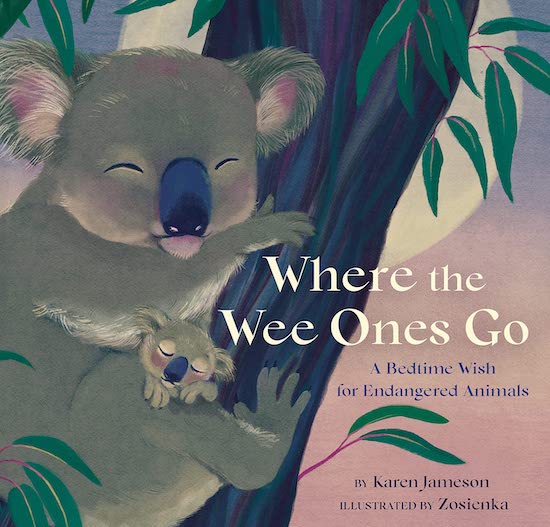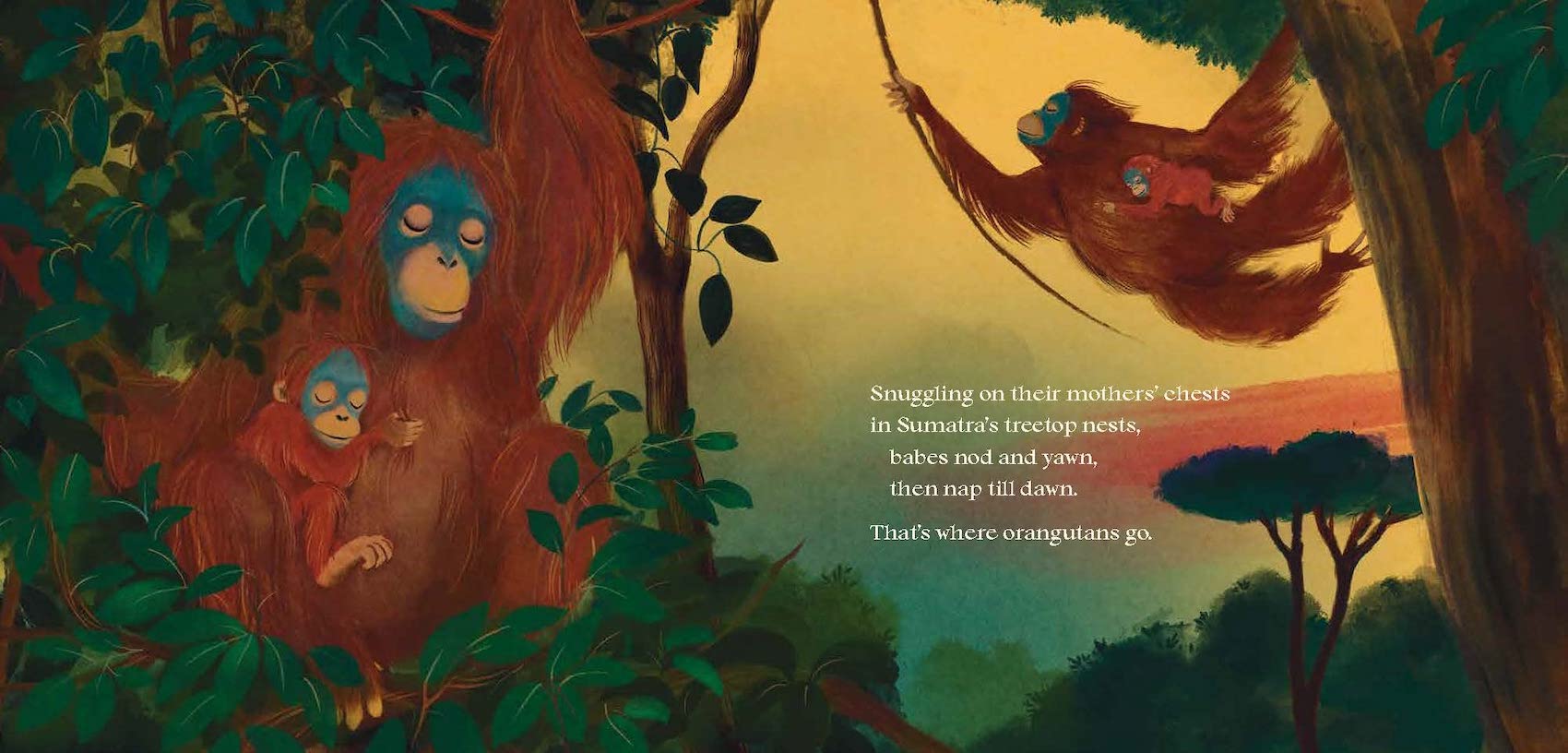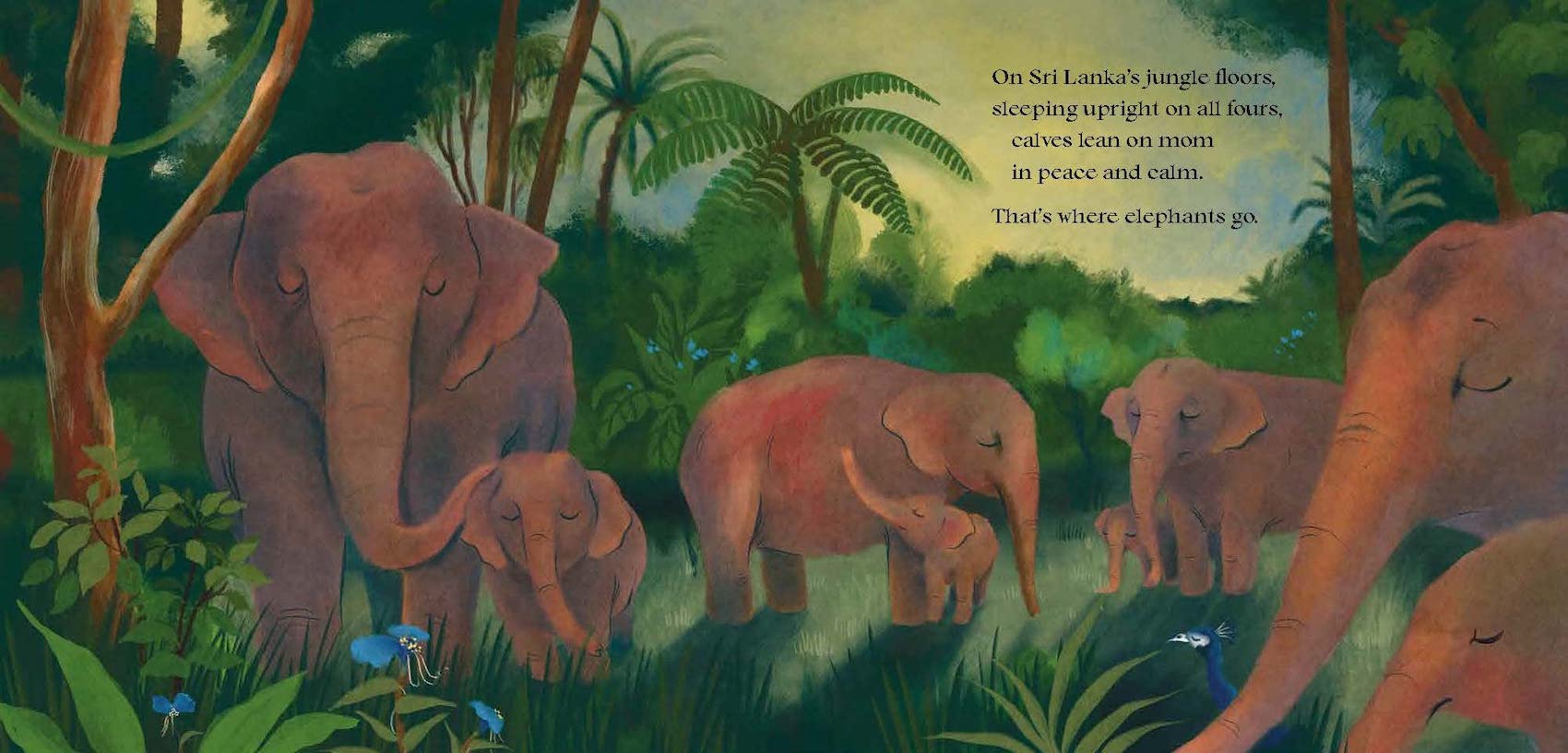
Chronicle Books | 978-1452184647
When the stars are out and the moon’s above.
Where do the wee ones go, my love?
Where do the wee ones go?
In WHERE THE WEE ONES GO: A Bedtime Wish for Endangered Animals, young ones will travel the world learning about twelve endangered animals as they ready to tuck in for a good night’s sleep. Karen Jameson‘s text sets the stage, immersing readers and listeners in a soothing, lyrical exploration of pandas in China, elephants in Sri Lanka, crocodiles on the Yangtze, and more. Zosienka’s illustrations, in rich, jeweled tones, add just the right touch of nighttime magic to snuggle up and send even the most reluctant night owl to sleep.
I’m excited to welcome back my good friend, Karen Jameson, for a peek behind the scenes of her newest book.
Dianne: Well, you’ve done it again! You’ve written another gorgeous lullaby book – WHERE THE WEE ONES GO: A Bedtime Wish for Endangered Animals – with luminous illustrations by Zozienka. How do you do it?! But more specifically, can you walk readers through the process from the first spark of inspiration to this beautiful “bedtime wish for endangered animals?”
How did you decide which 12 animals to include? Were there any additions or subtractions to your list after the manuscript was acquired?
Karen: Thanks so much, Dianne! The opening lines of WEE ONES were in my head and I was trying to figure out what that story might be about. One day, a critique partner mentioned seeing an endangered animals exhibit at the aquarium and I instantly knew I’d found my “wee ones.” Shortly afterwards, I discovered a global map of endangered animals (on the San Diego Zoo website) and that was my jumping off point. As a lullaby book, I knew it was important to feature animals with a variety of sleeping habits and habitats. A good mix of animal classes – mammals, reptiles, birds, etc,- was needed, too. Through trial and error, I came up with my list and whittled it down to a dozen. Thankfully, my editor loved the animals I’d chosen and no changes were needed.

© Zosienka
Dianne: We’ve talked in a previous ReaderKidZ post – HERE – about some of your process as you begin to explore what you imagine will be a rhyming text. You mentioned brainstorming lots of words related to your topic so that you have a good solid word bank to choose from. But I wanted to dig a little more deeply into what that brainstorming looks like. Do you make a general list of “bedtime words” and a more specific list of words for each animal you’re considering? Do you keep one file or separate files with info on each animal? Or maybe you use a special software, such as Scrivener? How do you organize your lists and the corresponding information as you begin to develop your story?

© Zosienka
Karen: For WEE ONES, I wanted to zoom in on these beautiful endangered animal babies in their natural habitats. As such, my brainstorming was more specific to each animal and focused on the “where” and “how” of their sleeping habits. I compiled a simple table of information for the book and dropped facts into the boxes as I went along. Of course, I maintained a file to keep track of my resources. I had a growing list of bedtime vocabulary (which proved handy) and kept my thesaurus and rhyming dictionary nearby, as I puzzled out the stanzas.
Dianne: Do you have a favorite animal that you knew from the very beginning you wanted to include? And, with over 7,000 endangered animals how did you decide what the balance of land and sea creatures in various continents and countries would be?
Karen: When my kids were little, we’d take day trips to the zoo and I was always drawn to the orangutans and elephants. Thankfully, they were both a great fit for the story! Sea turtles were another top contender, as only one out of a thousand babies makes it to adulthood. I could go on and on about why each animal was chosen, but suffice it to say that they all “spoke to me” in some way. The world map, mentioned above, was my constant reference point throughout the project, assuring a broad representation of endangered animals.
Dianne: I know you have several cool nonfiction books coming up, as well as some other projects in the works. Can you share what readers can look forward to next?
Karen: Thanks, Dianne! You won’t have to wait long for my next book! TIME TO SHINE: Celebrating the World’s Iridescent Animals, releases May 3rd. Published by Groundwood Books and illustrated by Dave Murray, this nonfiction picture book explores how animals use their iridescence to thrive and survive in nature. Next up, A LLAMA IS NOT AN ALPACA, illustrated by Lorna Scobie (RP Kids, March ‘23) and WAKE UP, WOODLANDS, illustrated by Marc Boutavant (Chronicle, Spring ’24). Stay tuned for more nonfiction news on the horizon!
Dianne: Thanks, again, Karen for hopping on ReaderKidZ to share more about your latest and upcoming projects. 🙂
Readers can learn more about Karen and her books here:
Check out these previous ReaderKidZ interviews with Karen!










